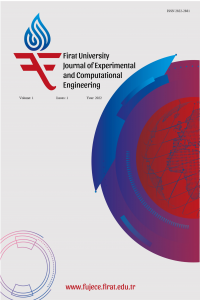Deep deterministic policy gradient reinforcement learning for collision-free navigation of mobile robots in unknown environments
Deep deterministic policy gradient reinforcement learning for collision-free navigation of mobile robots in unknown environments
___
- [1] Tufenkci S, Alagoz BB Kavuran G, Yeroglu C, Herencsar N, Mahata S. “A theoretical demonstration for reinforcement learning of PI control dynamics for optimal speed control of dc motors by using twin delay deep deterministic policy gradient algorithm”. Expert Syst. Appl., 213, 119192, 2023.
- [2] Sampedro C, Rodriguez-Ramos A, Bavle H, Carrio A, de la Puente P, Campoy P. “A Fully-autonomous aerial robot for search and rescue applications in ındoor environments using learning-based techniques”. J. Intell. Robot. Syst. Theory Appl., 95(2), 601–627, 2019.
- [3] Alavizadeh H, Alavizadeh H, Jang-Jaccard J, “Deep Q-learning based reinforcement learning approach for network ıntrusion detection”. Computers, 11(3), 1–19, 2022.
- [4] Uav F, Tan Z, Lyu Y, Lu H, Pan Q. “Motion primitives-based and Two-phase Motion Planning for”. 2022.
- [5] Krishnan S, Boroujerdian B, Fu W, Faust A, Reddi VJ. "Air Learning: a deep reinforcement learning gym for autonomous aerial robot visual navigation". Machine Learning, 110(9), 2021.
- [6] Stevsic S. Nageli T. Alonso-Mora J, Hilliges O, “Sample Efficient learning of path following and obstacle avoidance behavior for quadrotors”. IEEE Robot. Autom. Lett., 3,(4), 3852–3859, 2018.
- [7] Lockwood O, Si M. “A review of uncertainty for deep reinforcement learning”. Proc. AAAI Conf. Artif. Intell. Interact. Digit. Entertain, 18(1), 155–162, 2022.
- [8] Clifton J, Laber E. “Q-Learning : Theory and Applications”. Annual Review of Statistics and Its Application, 279–303, 2020.
- [9] Brockman G. et al., “OpenAI Gym”. 1–4, 2016, [Online]. Available: http://arxiv.org/abs/1606.01540.
- [10] Saglam B, Cicek DC, Mutlu FB, Kozat SS. “Off-Policy correction for actor-critic algorithms in deep reinforcement learning”. 2022.
- [11] Tsai J, Chang CC, Ou YC, Sieh BH, Ooi YM. “Autonomous driving control based on the perception of a lidar sensor and odometer”. Appl. Sci., 12(15), 2022.
- [12] Luong NC. et al., “Applications of deep reinforcement learning in communications and networking: a survey”. IEEE Commun. Surv. Tutorials, 21(4), 3133–3174, 2019.
- [13] Xiang J, Li Q, Dong X, Ren Z, “Continuous control with deep reinforcement learning for mobile robot navigation”. Proc. - 2019 Chinese Autom. Congr. CAC 2019, 1501–1506, 2019.
- [14] Tsingenopoulos I, Preuveneers D, Joosen W, “AutoAttacker: a reinforcement learning approach for black-box adversarial attacks”. Proc. - 4th IEEE Eur. Symp. Secur. Priv. Work. EUROS PW 2019229–237, 2019.
- [15] Andrychowicz M. et al., “Hindsight Experience replay (279 cites)”. Adv. Neural Inf. Process. Syst., 2017-Decem, no. Nips, 5049–5059, 2017.
- [16] Lindner T. Milecki A, Wyrwał D, “Positioning of the robotic arm using different reinforcement learning algorithms”. Int. J. Control. Autom. Syst., 19(4), 1661–1676, 2021.
- [17] Lucchi M, Zindler F, Muhlbacher-Karrer S, Pichler H. “Robo-gym - an open source toolkit for distributed deep reinforcement learning on real and simulated robots”. IEEE Int. Conf. Intell. Robot. Syst., 5364–5371, 2020.
- [18] James S, Freese M, Davison AJ. “PyRep: bringing v-rep to deep robot learning”. 1–4, 2019.
- [19] James S, Davison AJ, Johns E. “Transferring end-to-end visuomotor control from simulation to real world for a multi-stage task”. CoRL, 1–10, 2017.
- Başlangıç: 2022
- Yayıncı: Fırat Üniversitesi
A YARA-based approach for detecting cyber security attack types
Kubra Y ILDIRIM, Mustafa Emre DEMIR, Tugce KELES, Arif Metahan YILDIZ, Sengul DOGAN, Turker TUNCER
Musa YETKİN, Ömer Faruk TAŞ, Erkut SAYIN
Arif Metehan YILDIZ, Mehmet Veysel GUN, Kubra YILDIRIM, Tugce KELES, Sengul DOGAN, Turker TUNCER, U. Rajendra ACHARYA
